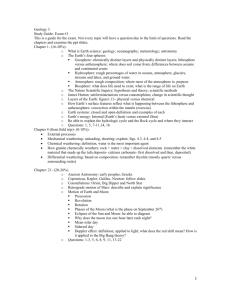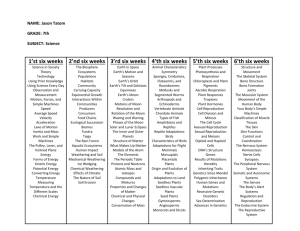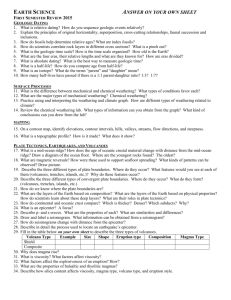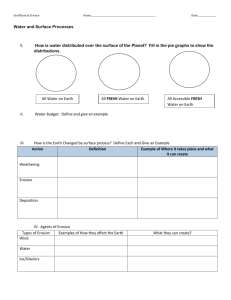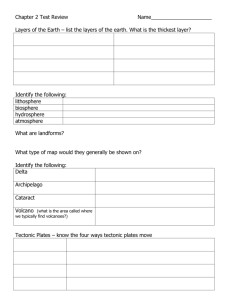International School of Broward Ms. Taoussi Hasna STUDY GUIDE
advertisement
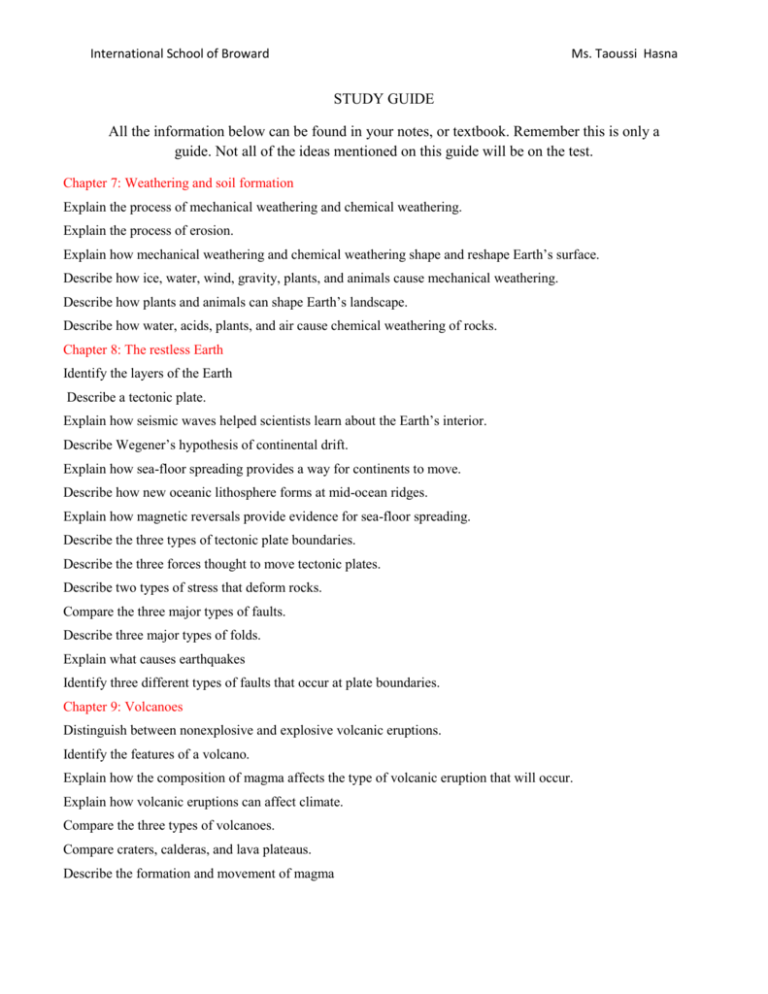
International School of Broward Ms. Taoussi Hasna STUDY GUIDE All the information below can be found in your notes, or textbook. Remember this is only a guide. Not all of the ideas mentioned on this guide will be on the test. Chapter 7: Weathering and soil formation Explain the process of mechanical weathering and chemical weathering. Explain the process of erosion. Explain how mechanical weathering and chemical weathering shape and reshape Earth’s surface. Describe how ice, water, wind, gravity, plants, and animals cause mechanical weathering. Describe how plants and animals can shape Earth’s landscape. Describe how water, acids, plants, and air cause chemical weathering of rocks. Chapter 8: The restless Earth Identify the layers of the Earth Describe a tectonic plate. Explain how seismic waves helped scientists learn about the Earth’s interior. Describe Wegener’s hypothesis of continental drift. Explain how sea-floor spreading provides a way for continents to move. Describe how new oceanic lithosphere forms at mid-ocean ridges. Explain how magnetic reversals provide evidence for sea-floor spreading. Describe the three types of tectonic plate boundaries. Describe the three forces thought to move tectonic plates. Describe two types of stress that deform rocks. Compare the three major types of faults. Describe three major types of folds. Explain what causes earthquakes Identify three different types of faults that occur at plate boundaries. Chapter 9: Volcanoes Distinguish between nonexplosive and explosive volcanic eruptions. Identify the features of a volcano. Explain how the composition of magma affects the type of volcanic eruption that will occur. Explain how volcanic eruptions can affect climate. Compare the three types of volcanoes. Compare craters, calderas, and lava plateaus. Describe the formation and movement of magma International School of Broward Ms. Taoussi Hasna Explain the relationship between volcanoes and plate tectonics. Summarize four methods scientists use to predict volcanic eruptions. Chapter 10: Astronomy and Chapter 11: Earth, Sun, and Moon Describe the composition of stars. Explain how stars differ in temperature, brightness, distance, size, and age Describe the three types of galaxies. Describe a star cluster Compare the planets and moons of the inner solar system with the planets and moons of the outer solar system. Explain the cause of daylight and night. Describe what causes equinoxes and solstices. Describe how latitude affects the amount of seasonal change that an area experiences. Explain how the Earth’s movement and the moon’s orbit cause the phases of the moon. Explain the difference between a solar eclipse and a lunar eclipse. Explain tides and their relationship with the Earth, sun, and moon. Explain the difference between rotation and revolution. Describe three laws of planetary motion Explain the cause of daylight and night. Explain how the tilt and movement of the Earth cause changes in seasons and the length of a day. Explain how the Earth’s movement and the moon’s orbit cause the phases of the moon. Chapter 12: It’s Alive!! Or Is It? Describe the six characteristics of living things, and describe how these characteristics are useful in classification. Describe how organisms maintain stable internal conditions. Explain how asexual reproduction differs from sexual reproduction Explain why organisms need water, air, living space, and food. Describe the chemical building blocks of cells Chapter 13: Introduction to cells Identify the structural basis of all organisms. Distinguish between prokaryotes and eukaryotes. Describe examples of single-celled and multicellular eukaryotes. Explain how an organism’s life functions are related to what happens inside the organism’s cells. Explain the differences between animal cells and plant cells. Compare the cell of a single-celled organism with the cells of multicellular organisms. Describe how cells with similar functions have similar structures.
